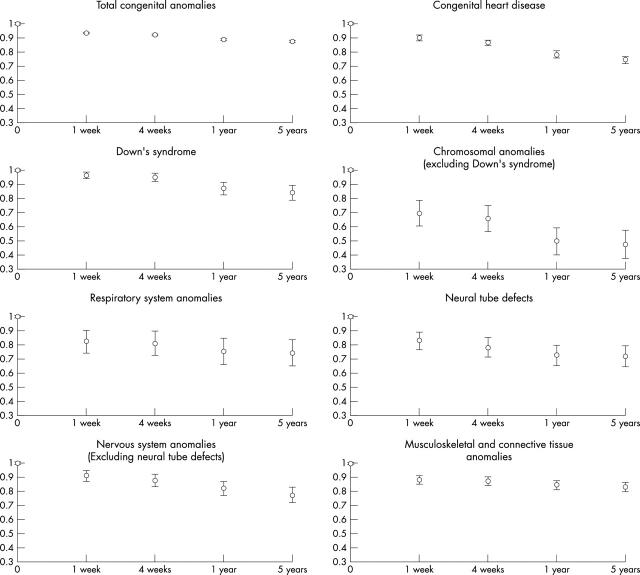Abstract
Aim: To describe the survival to age 5 years of children born with congenital anomalies.
Methods: Between 1980 and 1997, 6153 live born cases of congenital anomaly were diagnosed and registered by the population based Glasgow Register of Congenital Anomalies. They were retrospectively followed to assess their survival status from birth up to the age of 5 years.
Results: The proportions of all live born infants with congenital anomalies surviving to the end of the first week, and first and fifth year were 94%, 89%, and 88%, respectively. Survival to age 5, the end point of follow up, was significantly poorer for infants with chromosomal anomalies (48%) compared to neural tube defects (72%), respiratory system anomalies (74%), congenital heart disease (75%), nervous system anomalies (77%), and Down's syndrome (84%).
Conclusion: Although almost 90% of all live born infants with congenital anomalies survive to 5 years, there are notable variations in survival between anomaly types. Our findings should be useful for both clinicians and geneticists to assess the prognosis of congenital anomalies. This information is also important for affected families and for the planning of health care needs for this high risk population.
Full Text
The Full Text of this article is available as a PDF (163.2 KB).
Figure 1.
Survival of children with selected congenital anomalies (with 95% CI). x and y axes refer to "age at death" and "cumulative proportion surviving", respectively. Note that in some graphs, the large number of cases for total congenital anomalies results in extremely small confidence intervals, which are not properly visible.
Selected References
These references are in PubMed. This may not be the complete list of references from this article.
- Adams M. M., Greenberg F., Khoury M. J., Marks J. S., Oakley G. P., Jr Survival of infants with spina bifida--Atlanta, 1972-1979. Am J Dis Child. 1985 May;139(5):518–523. [PubMed] [Google Scholar]
- Castilla E. E., Rittler M., Dutra M. G., Lopez-Camelo J. S., Campaña H., Paz J. E., Orioli I. M. Survival of children with Down syndrome in South America. ECLAMC-Downsurv Group. Latin American Collaborative Study of Congenital Malformations. Am J Med Genet. 1998 Sep 1;79(2):108–111. doi: 10.1002/(sici)1096-8628(19980901)79:2<108::aid-ajmg6>3.0.co;2-m. [DOI] [PubMed] [Google Scholar]
- Dastgiri S., Stone D. H., Le-Ha C., Gilmour W. H. Prevalence and secular trend of congenital anomalies in Glasgow, UK. Arch Dis Child. 2002 Apr;86(4):257–263. doi: 10.1136/adc.86.4.257. [DOI] [PMC free article] [PubMed] [Google Scholar]
- Haase J., Green A., Hauge M., Holm N. V., Mathiasen H. A cohort study of neural tube defects (NTD) in Denmark covering the first seven years of life. Childs Nerv Syst. 1987;3(2):117–120. doi: 10.1007/BF00271138. [DOI] [PubMed] [Google Scholar]
- Hayes C., Johnson Z., Thornton L., Fogarty J., Lyons R., O'Connor M., Delany V., Buckley K. Ten-year survival of Down syndrome births. Int J Epidemiol. 1997 Aug;26(4):822–829. doi: 10.1093/ije/26.4.822. [DOI] [PubMed] [Google Scholar]
- Hou J. W., Wang T. R. Mortality and survival in Down syndrome in Taiwan. Zhonghua Min Guo Xiao Er Ke Yi Xue Hui Za Zhi. 1989 May-Jun;30(3):172–179. [PubMed] [Google Scholar]
- Kalter H. Five-decade international trends in the relation of perinatal mortality and congenital malformations: stillbirth and neonatal death compared. Int J Epidemiol. 1991 Mar;20(1):173–179. doi: 10.1093/ije/20.1.173. [DOI] [PubMed] [Google Scholar]
- Linhart Y., Bashiri A., Maymon E., Shoham-Vardi I., Furman B., Vardi H., Mazor M. Congenital anomalies are an independent risk factor for neonatal morbidity and perinatal mortality in preterm birth. Eur J Obstet Gynecol Reprod Biol. 2000 May;90(1):43–49. doi: 10.1016/s0301-2115(99)00196-7. [DOI] [PubMed] [Google Scholar]
- Lynberg M. C., Khoury M. J. Contribution of birth defects to infant mortality among racial/ethnic minority groups, United States, 1983. MMWR CDC Surveill Summ. 1990 Jul;39(3):1–12. [PubMed] [Google Scholar]
- Mastroiacovo P., Bertollini R., Corchia C. Survival of children with Down syndrome in Italy. Am J Med Genet. 1992 Jan 15;42(2):208–212. doi: 10.1002/ajmg.1320420214. [DOI] [PubMed] [Google Scholar]
- Powell-Griner E., Woolbright A. Trends in infant deaths from congenital anomalies: results from England and Wales, Scotland, Sweden and the United States. Int J Epidemiol. 1990 Jun;19(2):391–398. doi: 10.1093/ije/19.2.391. [DOI] [PubMed] [Google Scholar]
- Rosano A., Botto L. D., Botting B., Mastroiacovo P. Infant mortality and congenital anomalies from 1950 to 1994: an international perspective. J Epidemiol Community Health. 2000 Sep;54(9):660–666. doi: 10.1136/jech.54.9.660. [DOI] [PMC free article] [PubMed] [Google Scholar]
- Samánek M., Vorísková M. Congenital heart disease among 815,569 children born between 1980 and 1990 and their 15-year survival: a prospective Bohemia survival study. Pediatr Cardiol. 1999 Nov-Dec;20(6):411–417. doi: 10.1007/s002469900502. [DOI] [PubMed] [Google Scholar]
- Wen S. W., Liu S., Joseph K. S., Rouleau J., Allen A. Patterns of infant mortality caused by major congenital anomalies. Teratology. 2000 May;61(5):342–346. doi: 10.1002/(SICI)1096-9926(200005)61:5<342::AID-TERA5>3.0.CO;2-7. [DOI] [PubMed] [Google Scholar]
- Wen S. W., Liu S., Joseph K. S., Trouton K., Allen A. Regional patterns of infant mortality caused by lethal congenital anomalies. Can J Public Health. 1999 Sep-Oct;90(5):316–319. doi: 10.1007/BF03404519. [DOI] [PMC free article] [PubMed] [Google Scholar]
- Wren C., O'Sullivan J. J. Survival with congenital heart disease and need for follow up in adult life. Heart. 2001 Apr;85(4):438–443. doi: 10.1136/heart.85.4.438. [DOI] [PMC free article] [PubMed] [Google Scholar]
- Yang Q., Khoury M. J., Mannino D. Trends and patterns of mortality associated with birth defects and genetic diseases in the United States, 1979-1992: an analysis of multiple-cause mortality data. Genet Epidemiol. 1997;14(5):493–505. doi: 10.1002/(SICI)1098-2272(1997)14:5<493::AID-GEPI4>3.0.CO;2-2. [DOI] [PubMed] [Google Scholar]



